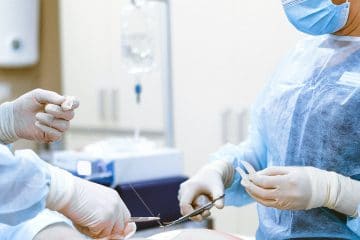What is Microsurgery? – Overview
Microsurgery refers to a surgical operation that is performed with the aid of a surgical microscope. A surgical microscope or operation microscope is an optical instrument that provides the surgeon with a stereoscopic, high quality magnified and illuminated image of the small structures in the surgical area.
Microsurgery is utilized by several specialties today ranging from general surgery, ophthalmology, orthopedic surgery, gynecological surgery, otolaryngology, neurosurgery, oral and maxillofacial surgery, plastic surgery, podiatric surgery and pediatric surgery.
History of Microsurgery
Surgeons that operate on the head and neck (otolaryngologists) were the first physicians to use microsurgical techniques. A Swedish otolaryngologist, Carl-Olof Siggesson Nylén (1892–1978), was the father of microsurgery. In 1921, in the University of Stockholm, he built the first surgical microscope, a modified monocular Brinell-Leitz microscope.
The advances in the techniques and technology that popularized microsurgery began in the early 1960s to involve other medical areas. The first microvascular surgery, using a microscope to aid in the repair of blood vessels, was described by vascular surgeon, Julius H. Jacobson II of the University of Vermont in 1960. Using an operating microscope, he performed coupling of vessels as small as 1.4 mm and coined the term microsurgery. Hand surgeons at the University of Louisville (KY), Drs. Harold Kleinert and Mort Kasdan, performed the first revascularization of a partial digital amputation in 1963
Microsurgery Procedures
A number of surgical operations are performed using an operating microscope. These microsurgical procedures include: free tissue transfer, replantation, transplantation and infertility treatment.
Free Tissue Transfer
Free tissue transfer, also known as free flap is a surgical reconstructive procedure using microsurgery. It is the “transplantation” of tissue from one site of the body to another, in order to reconstruct an existing defect.
“Free” implies that the tissue is completely detached from its blood supply at the original location (“donor site”) and then transferred to another location (“recipient site”) and the circulation in the tissue re-established by anastomosis of artery(s) and vein(s).
An example of “free flap” could be a “free toe transfer” in which the great toe or the second toe is transferred to the hand to reconstruct a thumb.
Replantation
Replantation is the reattachment of a completely detached body part Fingers and thumbs are the most common but the ear, scalp, nose, face, arm and penis have all been replanted. Generally replantation involves restoring blood flow through arteries and veins, restoring the bony skeleton and connecting tendons and nerves as required.
Transplantation
Transplantation is a medical procedure in which an organ is removed from one body and placed in the body of a recipient, to replace a damaged or missing organ. The donor and recipient may be at the same location, or organs may be transported from a donor site to another location. Organs and/or tissues that are transplanted within the same person’s body are called autografts. Transplants that are recently performed between two subjects of the same species are called allografts. Allografts can either be from a living or cadaveric source.
More: Kidney Transplant Facts
Treatment of infertility
Microsurgery has been used to treat several pathologic conditions leading to infertility such as tubal obstructions, vas deferens obstructions and varicocele which is one of the most frequent cause of male infertility. Microsurgical drainages by placing micro vascular bypasses between spermatic and inferior epigastric veins as proposed by Flati et al. have been successfully performed in treating male infertility due to varicocele. Microsurgical treatment has been shown to significantly improve fertility rate also in patients with recurrent varicocele who had previously undergone non microsurgical treatments.
More: Types of Surgery


